Welcome to Northmavine
One hundred years ago this part of the isles was described as “the largest, wildest and most beautiful parish in Shetland”– the same could be said today. Northmavine draws people from near and far to discover its outstanding coastline, superb walking country, rich variety of wildlife, rocks and plants, and its fascinating array of historical and archaeological remains.
Almost an island in its own right, only the narrow isthmus at Mavis Grind joins it to the rest of the mainland of Shetland. It has often been said that here you can stand on the shore of the North Sea and throw a stone into the Atlantic Ocean on the other side, though you would need a strong arm!
From Mavis Grind you enter a vast and magical landscape dominated by Shetland’s highest summit, Ronas Hill (450 metres). To the east lies Sullom Voe, Shetland’s largest sea inlet, and to the west is St. Magnus Bay and the Atlantic Ocean, which has battered the land into a scene of breath taking beauty. The coastline throughout Northmavine is remarkable, with magnificent cliffs, extraordinary rock formations, beautiful, deserted beaches and tranquil, sheltered voes. Inland this hilly country, peppered with trout-filled lochs, provides excellent walking, angling and unrivalled views.
Bird, Beast, Rock and Plant
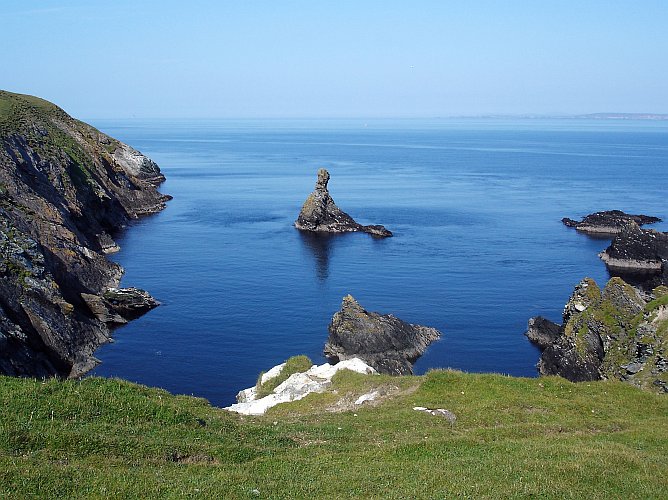 Fedaland Cliffs
Fedaland Cliffs
 The wildness and the range of different habitats in Northmavine make it a perfect place for watching wildlife, so don’t forget your binoculars.
The wildness and the range of different habitats in Northmavine make it a perfect place for watching wildlife, so don’t forget your binoculars.
The coast at Eshaness, the Ness of Hillswick, Fethaland and the banks (cliffs) around Ronas Hill are home to thousands of seabirds, with many important breeding colonies including numerous colonies of Arctic Tern.
There are many vantage points from which to watch Grey and Common Seals basking in the sun or playing in the sea. The isle of Uyea is a significant pupping ground for Grey Seals. The quiet and watchful might spy an otter working its way along the shore line, particularly on the Hillswick Ness or between Ollaberry and Sullom.
Looking out to sea you might even catch sight of whales, dolphins or porpoises. Inland the vast expanse of moor, peat and loch attract many different birds. The fierce Bonxie (Great Skua) and Skootie Alan (Arctic Skua) are widespread in Eshaness and on Ronas Hill. A keen eye could glimpse the quick flash of a Merlin hunting its prey, while the mournful call of a Golden Plover is a common sound in summer.
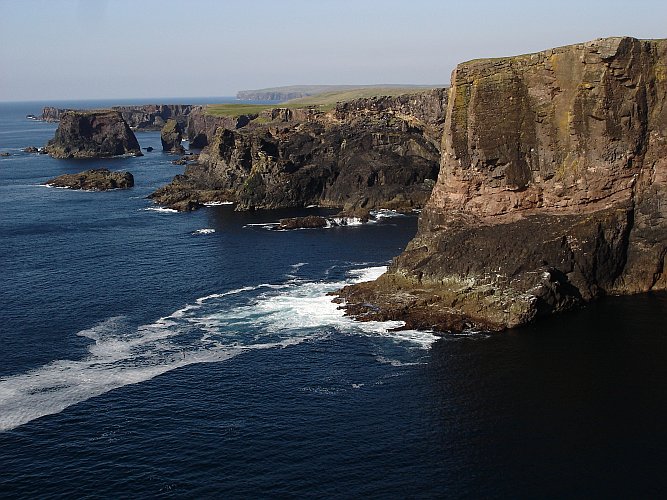 Cliffs at Eshaness
Cliffs at Eshaness
 The fire and ice of volcano and glacier have forged Shetland’s world famous geology. Some of Britain’s oldest rocks, nearly three billion years old, are at Uyea. The volcanic rocks – black basalts and purple andesites – that form the cliffs at Eshaness contain agates and amethysts. Ollaberry has perhaps Britain’s finest example of a tear fault, part of a fault line that extends to Inverness and along the Great Glen.
The fire and ice of volcano and glacier have forged Shetland’s world famous geology. Some of Britain’s oldest rocks, nearly three billion years old, are at Uyea. The volcanic rocks – black basalts and purple andesites – that form the cliffs at Eshaness contain agates and amethysts. Ollaberry has perhaps Britain’s finest example of a tear fault, part of a fault line that extends to Inverness and along the Great Glen.
Wildflowers are abundant throughout the summer, especially in the meadows around Ollaberry, North Roe and on Hillswick Ness. Several rare species occur, such as the Oyster Plant, at Urafirth. Many unusual alpine and Arctic-alpine plants grow on Ronas Hill, while cliffs and crevices support some of the last remaining native trees and shrubs which covered these wind swept isles thousands of years ago before man introduced grazing animals.
The spectacular Atlantic coastline from the Ness of Hillswick north to Uyea has no comparison elsewhere in Shetland. Here the unrelenting power of the ocean has carved an astounding display of cliffs, stacks, geos, blowholes, natural arches and caves.
Eshaness lighthouse is a superb place from which to savour the cliff scenery. From here an easy walk leads you to two particularly impressive features. Please remember to take care when walking along this coastline.
The Hols o Scraada (Old Scratch, or the Devil) were formed when the roof caved in at the end of a deep and narrow sea cave stretching more than one hundred yards in from the coast.
Further on stands the Grind o da Navir (Gate of the Borer), a huge, vertical sided gateway in the cliffs. Here the sea has ripped a huge chunk of rock out of the cliff face and hurled it inland. Nearby lies the Loch of Houlland, where the ruin of a broch provides an excellent example of Iron Age architecture.
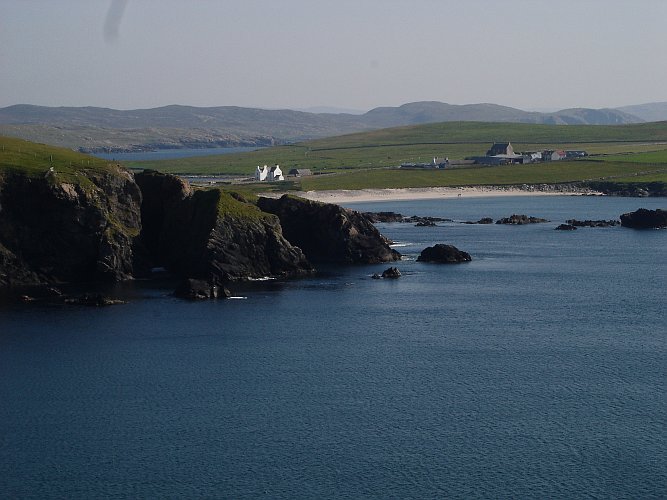 Coastal View of Northmavine
Coastal View of Northmavine
 The more adventurous will ascend Ronas Hill to discover the mountainous terrain at its peak, where a fine example of a chambered cairn awaits them. From here, on a clear day, the view is unsurpassed, taking in all of Shetland from Fair Isle to Muckle Flugga.
The more adventurous will ascend Ronas Hill to discover the mountainous terrain at its peak, where a fine example of a chambered cairn awaits them. From here, on a clear day, the view is unsurpassed, taking in all of Shetland from Fair Isle to Muckle Flugga.
Plenty of time should be reserved to explore the huge red cliffs west of Ronas Hill, Shetland’s largest beach at Lang Ayre and the many lochs in the area. Up here it is wise to be well equipped with map and compass as mists can appear suddenly to restrict visibility - be warned, the climate here can be every bit as extreme as the Cairngorm plateau.
Other impressive walks can be enjoyed around the Ness of Hillswick, between Hillswick and Braewick, around Fethaland, out to Uyea, along Ronas Voe past Heylor, at Nibon and Mangaster and Gluss Isle and Bardister, near Ollaberry. All offer a wide range of wildlife, rock features and archaeological remains, as well as beautiful scenery.
A Wealth of History
Fishing and crofting have always been the mainstays of Shetland life, though much has changed since the not so distant past when the sea was the highway and the engine unknown. The old way of life continued almost unchanged until World War II announced itself with the first bomb to be dropped on British soil landing in Sullom. The sole casualty was a rabbit, allegedly inspiring the famous wartime song “Run Rabbit Run”.
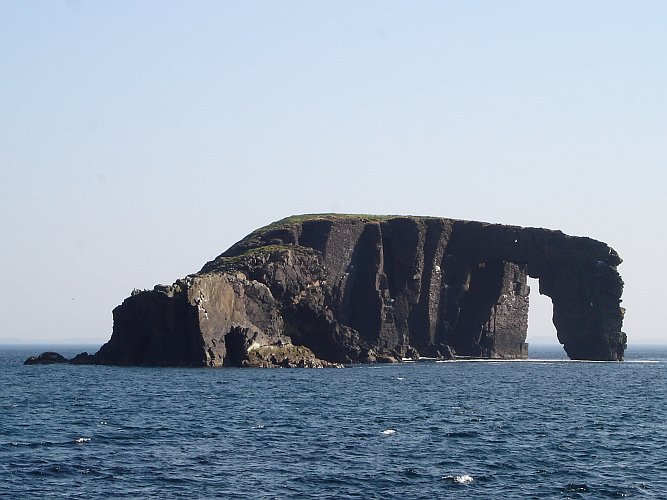 Dore Holm
Dore Holm
 Many fine examples of times past can be seen in Northmavine. Easily accessible are the shore front at Hillswick where the man-made beach was used for drying fish. Here The Booth, a former Hanseatic trading post, has stayed in business for more than 300 years. Since the turn of this century it has been overlooked by the large, wooden pavilion from Norway, displayed at Glasgow’s Great Exhibition, in 1899, and for many years after that a hotel.
Many fine examples of times past can be seen in Northmavine. Easily accessible are the shore front at Hillswick where the man-made beach was used for drying fish. Here The Booth, a former Hanseatic trading post, has stayed in business for more than 300 years. Since the turn of this century it has been overlooked by the large, wooden pavilion from Norway, displayed at Glasgow’s Great Exhibition, in 1899, and for many years after that a hotel.
Also nearby are a set of restored cutch kettles (pronounced cootch) once used in the preservation of sails and nets for fishing boats.
Further afield on Stenness beach stand the ruins of fishing lodges, reminding us of the “far haaf” open sea fishing, which flourished in the 18th and 19th centuries. Men would set out to sea for days on end in open rowing boats called sixareens not returning until they were laden with fish.
Fethaland was once Shetland’s busiest haaf fishing station. Sixty sixareens were based here and the ruins of twenty lodges still stand, retaining the atmosphere of the time. Close by, a circular mound is believed to be the remains of a 4000 year old homestead.
The Vikings left their mark on a nearby soapstone cliff where it is possible to distinguish the shapes of urns and bowls where they were carved from the cliff face.
Fethaland is some distance to walk, as are the green pastures of Uyea where a crofting community thrived until early this century. The well preserved buildings are still used by crofters today. Crofting continues throughout the parish.
The fishing industry lives on at Collafirth pier, built in 1988 on the site of an old Norwegian whaling station and now home to one of Britain’s largest fishing boats. Smaller inshore boats work from Hamnavoe and Hillswick as well as Collafirth.
The picture of the modern Shetland economy is completed with salmon farms in several of Northmavine’s voes and the best view of Europe’s largest oil terminal, at Sullom Voe, from Ollaberry.
Tangwick Haa
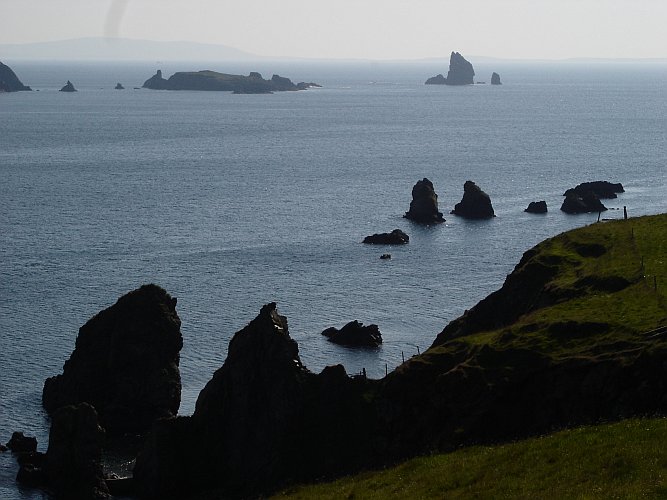 A view to sea from Northmavine
A view to sea from Northmavine
 All aspects of life in Northmavine over the years are well illustrated in the displays at Tangwick Haa Museum at Eshaness. The Haa was built in the late 17th century for the Cheyne family, lairds of the Tangwick Estate and elsewhere in Shetland
All aspects of life in Northmavine over the years are well illustrated in the displays at Tangwick Haa Museum at Eshaness. The Haa was built in the late 17th century for the Cheyne family, lairds of the Tangwick Estate and elsewhere in Shetland
Johnnie Notions
John Williamson of Hamnavoe, known as Johnnie Notions for his inventive mind, was one of Northmavine’s great characters. Though uneducated, he designed his own inoculation against smallpox, saving thousands of local people from this 18th century scourge of Shetland, without losing a single patient.
Tom Anderson
Another famous son of Northmavine was Dr Tom Anderson MBE. A prolific composer of fiddle tunes and a superb player, he is perhaps best remembered for his work in teaching young fiddlers and for his role in preserving Shetland’s musical heritage. He was awarded an honorary doctorate from Stirling University for his efforts in this field.
Some Useful Information
| Neighbourhood Information Point: | Tangwick Haa Museum, Eshaness |
| Shops: | Hillswick, Ollaberry |
| Fuel: | Ollaberry |
| Public Toilets: | Hillswick, Ollaberry, Eshaness |
| Places to Eat: | Hillswick, Eshaness |
| Post Offices: | Hillswick, Ollaberry, North Roe |
| Public Telephones: | Sullom, Ollaberry, Leon, North Roe, Hillswick, Urafirth, Eshaness |
| Churches: | Sullom, Hillswick, North Roe, Ollaberry |
| Doctor: | Hillswick, Tel: 01806 503277 |
| Police Station: | Brae, Tel: 01806 522381 |


